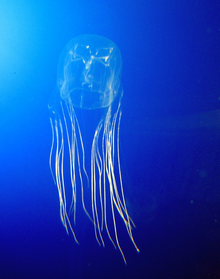Box jellyfish
| Box jellyfish | |
|---|---|
 |
|
| Chironex sp. | |
 |
|
| Carukia barnesi | |
| Scientific classification | |
| Kingdom: | Animalia |
| Phylum: | Cnidaria |
| Class: |
Cubozoa Werner, 1975 |
| Orders | |
Box jellyfish (class Cubozoa) are cnidarian invertebrates distinguished by their cube-shaped medusae. Some species of box jellyfish produce extremely potent venom: Chironex fleckeri, Carukia barnesi and Malo kingi. Stings from these and a few other species in the class are extremely painful and can be fatal to humans.
"Box jellyfish" and "sea wasp" are common names for the highly venomous Chironex fleckeri. However, these terms are ambiguous, as "sea wasp" and "marine stinger" are sometimes used to refer to other jellyfish.
The medusa form of a box jellyfish has a squarish, box-like bell. From each of the four lower corners of this hangs a short pedalium or stalk which bears one or more long, slender, hollow tentacles. The rim of the bell is folded inwards to form a shelf known as a velarium which restricts the bell's aperture and creates a powerful jet when the bell pulsates. As a result, box jellyfish can move more rapidly than other jellyfish; speeds of up to six meters per minute have been recorded.
In the center of the underside of the bell is a mobile appendage called the manubrium which somewhat resembles an elephant's trunk. At its tip is the mouth. The interior of the bell is known as the gastrovascular cavity. It is divided by four equidistant septa into a central stomach and four gastric pockets. The eight gonads are located in pairs on either side of the four septa. The margins of the septa bear bundles of small gastric filaments which house and digestive glands and help to subdue prey. Each septum is extended into a septal funnel that opens onto the oral surface and facilitates the flow of fluid into and out of the animal.
The box jellyfish's nervous system is more developed than that of many other jellyfish. They possess a nerve ring around the base of the bell that coordinates their pulsing movements, a feature found elsewhere only in the crown jellyfish. Whereas some other jellyfish have simple pigment-cup ocelli, box jellyfish are unique in the possession of true eyes, complete with retinas, corneas and lenses. Their eyes are set in clusters called rhopalia, located in pockets halfway up the outer, flat surfaces of the bell. Each contains two rhopalial ocelli with lenses, one directed upwards and the other downwards and inwards towards the manubrium. This enables the animal to see specific points of light, as opposed to simply distinguishing between light and dark. Box jellyfish also have twenty ocelli (simple eyes) that do not form images, but detect light and dark; they therefore have a total of twenty-four eyes. Near the rhopalia are which detect gravitational pull and help the animal to orient itself.
...
Wikipedia
